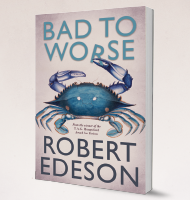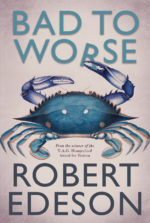What’s in a book cover design?

Sometimes a book fits into a very specific genre – a genre whose covers have a very specific set of codes that signal to readers what they can expect to find in that book. We all know, for instance, what kind of material will be in a book featuring the upper body of Fabio. But what about those books that are considered genre-busting?
Books that don’t automatically fit into one particular category but which cut across many? How do you design a book cover for a title that is both speculative fiction and crime? We asked Fremantle Press publisher Georgia Richter.
When publishing a novel as difficult to categorise as Robert Edeson’s Bad to Worse, preparing a cover brief can be somewhat challenging. But after all, I, as the publisher, only have to formulate the question: the designer must answer it!
The image for a book cover can come from anywhere and everywhere. For Bad to Worse, designer Nada Backovic’s search led her to the Amon Carter Museum of American Art in Fort Worth, Texas, and a zoological drawing dated around 1830. The drawing, created by Christophe-Paulin de la Poix, Chevalier de Fréminville, depicts two rather magnificent specimens and is titled Portunus quadriguttatus, the Swimming Crab (La cérique à quatre taches) and Ocypoda uca, the Fiddler Crab (L’uca de Marcgrave). That blue crab at the top of the image came to appear in a variety of graphics on Nada’s draft cover designs: there it was, snipping a cactus in two, clutching at a sheriff’s badge, in silhouette above a listing cruise ship and, last but not least, gamely gripping a drone.
What would the artist Christophe-Paulin de la Poix make of the latest display of the drawing of his exquisite swimming crab, nearly 200 years after he first drew it? De la Poix was a French naval commander with a colourful CV. He was an adventurer who seems to have been gripped by a desire for exploring the world. He fought in battles various, and sailed to the North Pole to intimidate British whalers. He spotted the elusive Isle of Enckuysen and (some time later) fell in love with a Creole woman in the Caribbean.
I suspect that de la Poix, as an archaeologist, and a naturalist with a clear gift for drawing, would have hugely enjoyed Edeson’s story of nefarious dealings on the high seas and of ancient hieroglyphs that cover the wall of an underground cave and offer up a seemingly uncrackable code. Would he have raised an elegant French eyebrow at the monstrous bipedal crab that dwells deep within the cave system in Edeson’s Ferendes? I think not. I suspect rather that de la Poix and Edeson might have been kindred spirits. While de la Poix settled down to read Bad to Worse, he may have slipped Edeson a copy of his essay (written under a pseudonym) on the topic of ‘the physical and moral influence of the female costume’* – surely the only element missing from Edeson’s oeuvre thus far.
*as described by Levot Prosper in his 1866 publication Les gloires maritimes de la France: notices biographiques sur les plus célèbres marins.
 Christophe-Paulin de la Poix, Chevalier de Freminville; Portunus quadriguttatus, the Swimming Crab (La cérique à quatre taches) and Ocypoda uca, the Fiddler Crab (L’uca de Marcgrave); c. 1822–1839; Watercolour, ink and graphite on paper; Amon Carter Museum, Fort Worth, Texas; 1983.160.
Christophe-Paulin de la Poix, Chevalier de Freminville; Portunus quadriguttatus, the Swimming Crab (La cérique à quatre taches) and Ocypoda uca, the Fiddler Crab (L’uca de Marcgrave); c. 1822–1839; Watercolour, ink and graphite on paper; Amon Carter Museum, Fort Worth, Texas; 1983.160.



